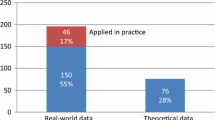Abstract
This report extends and updates a 1996 paper ondepartmental planning of workload for academicsin UK universities. Categories of workloadplanning system can be discerned by introducinga set of differentiating dimensions. Usingthis taxonomy the situation in departments in a(pre-1992) UK university is explored via casestudy and survey. The study finds a highdegree of variety and limited reliance onformal workload planning systems. The questionof whether these systems are effective isconsidered and leads on to identifying keycriteria for effective systems. Increasedenvironmental pressures are driving departmentsto confront workload planning in a morerigorous and effective manner.
Similar content being viewed by others
References
Ackoff, R.L. (1967). 'Management misinformation myths', Management Science14(4), B147-B156.
Anon. (1999). Transparency Review of Research: Proposal for a New Uniform Approach to the Costing of Research and other Activities in Universities and Colleges of Higher Education.Bristol: JM Consulting Ltd.
Becher, T. and Kogan, M. (1992). Process and Structure in Higher EducationLondon: Routledge.
Bull, G.M., Dallinga-Hunter, C., Epelboin, Y., Frackman, E. and Jennings, D. (1994). Information Technology: Issues for Higher Education. London: Jessica Kingsley Publishers.
Burgess, T.F. (1996). 'Planning the academic's workload: different approaches to allocating work to university academics', Higher Education32, 63–75.
Davis, G.B. and Olson, M.H. (1985). Management Information Systems. New York: McGraw-Hill Book Company.
Emery, F.E. and Trist, E.L. (1960). 'Sociotechnical systems', in Churchman, C.W. and Verhulst, M.C. (eds.), Management Science, Models and Techniques, Vol 2. Pergamon Press.
Finlay, P.N. and Gregory, C. (1994). 'A management support system for directing and monitoring the activities of university staff', Journal of the Operational Research Society45, 641–650.
Golden, B.R., Dukerich, J.M. and Fabian, F.H. (2000). 'The interpretation and resolution of resource allocation issues in professional organizations: a critical examination of the professional-manager dichotomy', Journal of Management Studies37(8), 1157–1187.
Gourley, B. (2001). 'Watch out for scavengers', Times Higher Education Supplement 20th April, p.
Henkel, M. (2000). Academic Identities and Policy Change in Higher Education. London: Jessica Kingsley Publishers.
Higson, H., Filby, J. and Golder, V. (1998). 'A critique of a model for an academic staff activity database developed to aid a department in strategic and operational decision-making', Perspectives2(1), 28–32.
Laudon, K.C. and Laudon, J.P. (1998). Management Information Systems: New Approaches to Organization and Technology. Uppers Saddle River, New Jersey: Prentice Hall, Inc.
Leeds AUT (2001). Statement on University Workloads Policy Leeds Association of University Teachers, 17th September.
Marcus, L.R. (1999). 'The micropolitics of planning', The Review of Higher Education23(1), 45–64.
McAuley, J., Duberley, J. and Cohen, L. (2000). 'The meaning professionals give to management.
Monbiot, G. (2000). Captive State: The Corporate Takeover of Britain. London: Macmillan. '
Nichoson, T.A.J. (1989). 'Planning and managing capacity', in Wild, R. (ed.), International Handbook of Production and Operations Management. London: Cassell Education, pp. 77–88
Salinger, D. (2002). 'AUT Council Report', in Leeds AUT Newsletter. Leeds Association of University Teachers.
Sauve, P. and Stern, R.M. (eds.) (2000). GATS 2000: New Directions in Services Trade Liberalization. Washington: Brookings Institute Press.
Scott, P. (1995). The Meanings of Mass Higher Education. Buckingham: Society for Research into Higher Education and Open University Press.
Simon, H.A. (1960). The New Science of Management Decision. New York: Harper and Row.
Stowell, F., West, D. and Stansfield, M. (1997). 'Action research as a framework for IS research', in Mingers, J. and Stowell, F. (eds.), Information Systems: An Emerging Discipline?Maidenhead: McGraw-Hill, pp. 159–200.
Stringer, E.T. (1999). Action Research. Sage Publications.
Author information
Authors and Affiliations
Corresponding author
Rights and permissions
About this article
Cite this article
Burgess, T., Lewis, H. & Mobbs, T. Academic workload planning revisited. Higher Education 46, 215–233 (2003). https://doi.org/10.1023/A:1024787907547
Issue Date:
DOI: https://doi.org/10.1023/A:1024787907547




